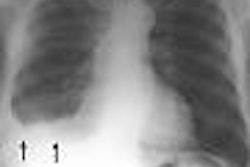The worst thing about FE-36, the new fire extinguishing agent from DuPont, could be just an unfortunate coincidence in acronyms. For those charged with MR facility safety, any object with iron (chemical abbreviation, Fe) is to be strictly avoided. So it is not without irony (pun not intended) that FE-36 is being released and marketed to MR facilities.
What is purported to make FE-36 better than whatever you might have in the extinguisher cabinet down the hall? Two principal reasons: better fire suppression and better magnet safety.
A number of fire extinguishing agents for portable extinguishers are available, but only two, CO2 and deionized water, are widely used in MR facilities. The limited selection is due in part to the limitations of a nonferromagnetic pressure vessel. Unfortunately, before today, the two front-runners in the portable fire extinguisher race haven't been well-suited to the range of fires that can occur in an MR suite.
The three most common types of fires (and extinguisher classes) are:
- Class A: Normal combustibles (paper, wood, plastic, etc.)
- Class B: Flammable liquids (gasoline, grease, solvents, etc.)
- Class C: Electrical fires (short circuits, locked motors, etc.)
CO2 extinguishers are very good at class B and C fires, but there just isn't much of a chance of a grease fire breaking out in your magnet room (at least, we hope not). Unfortunately, CO2 extinguishers aren't the most effective choice for trash can fires and other common combustibles. Deionized water is perfect for class A fires, but can be dangerous for both class B and C fires. And while the deionization of the water is supposed to make the water less likely to damage electronics, there's still the risk that you could be injured by the electricity. FE-36, by contrast, is rated very well for all three common classes of fires.
DuPont of Wilmington, DE, and Ansul of Marinette, WI, have developed an MR-safe pressure vessel and have tested it in real MR environments at field strengths up to 3 tesla, so there's no trade-off between better extinguishing capability and magnet safety. Ansul is marketing the new magnet-safe portable extinguisher with the FE-36 agent as the CleanGuard FE13NM.
Although it was a portable steel oxygen cylinder and not a fire extinguisher that killed pediatric patient Michael Colombini in a tragic MRI accident in 2001, the number of imaging facilities that have steel-cylinder fire extinguishers is unsettling. A small trash can fire in a magnet room could easily lead to another fatal accident.
The charge to every MR facility
First, review the requirements of your municipality, state, and the Joint Commission on Accreditation of Healthcare Organizations (JCAHO). Then make sure that you comply with the most restrictive rules.
Second, check all of your fire extinguishers. Knowing that you have MR-safe extinguishers isn't enough -- you need to verify where they are and ensure that they haven't been taken offsite to be recharged and replaced with a ferrous cylinder.
Third, assess your fire risks and determine what extinguisher best suits your needs.
Finally, make sure your portable extinguishers are conspicuously labeled as MR-safe and not swapped out by the contractor that maintains your extinguishers.
And if you do find steel fire extinguisher cylinders in your facility, immediately order MR-safe replacements. Even a plastic bucket of water, while not a legal substitute for a code-mandated fire extinguisher, is ultimately safer than a steel cylinder in your MR suite.
By Robert Junk and Tobias Gilk
AuntMinnie.com contributing writers
September 22, 2004
Reprinted from www.mri-planning.com by permission of the authors. If you would like more information about DuPont's new FE-36 fire extinguishing agent, the Ansul CleanGuard FE13NM portable cylinder, or any other aspect of MR facility design or safety, please contact Robert Junk or Tobias Gilk at Jünk Architects. If you would like a free ferrous tester to test the fire extinguisher in your imaging suite, courtesy of Jünk Architects, click here for the request form.
Related Reading
Method allows for fast removal of navel jewelry before medical interventions, September 8, 2004
What your vendor may not have told you about magnetic contamination, July 27, 2004
Universal room design can mitigate change costs, May 16, 2003
Facility-planning implications of the new MRI safety guidelines, September 9, 2002
MRI design resonates with functional, aesthetic qualities, July 22, 2002
Copyright © 2004 Jünk Architects


.fFmgij6Hin.png?auto=compress%2Cformat&fit=crop&h=100&q=70&w=100)





.fFmgij6Hin.png?auto=compress%2Cformat&fit=crop&h=167&q=70&w=250)











